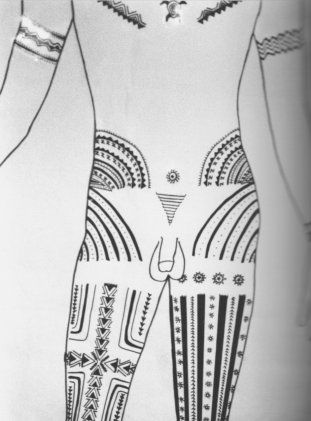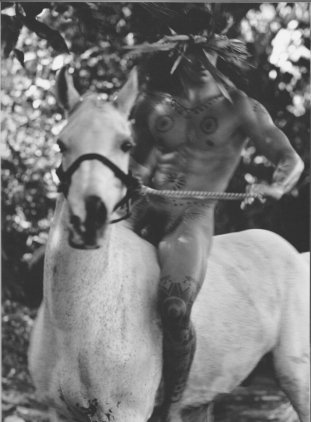

 |
 |
Polynesia consists of a widespread group of islands in the Pacific whose inhabitants share a common culture and closely related languages. They fall, roughly, in a large triangle with Hawaii, New Zealand and Rapa Nui (Easter Island) at the north, south-east and west corners, respectively. Some are independent nations, Hawaii is a state of the USA, Easter Island (Rapa Nui) belongs to Chile and a group of islands, including Tahiti, collectively form French Polynesia. Cook and Niue Islands are self-governing associates of New Zealand. The flag and coat of arms shown above are those of Samoa, the founding chair of the Polynesian Leaders Group, an association of 8 Polynesian states.

Circumcision is almost universal in Polynesian society, the only exception being among the Maoris - see our New Zealand page. It seems that the struggle to adapt to a very different, and colder, environment in New Zealand led to the loss of traditional practices, as has happened elsewhere. In most places a simple dorsal slit is carried out, but some islands do a full circumcision. The age at which the operation is performed also varies from place to place - remember we are talking about very widely scattered populations.

Anthropologist Bengt Danielsson quotes a study of the customs on Tongareva, in the Cook Islands.
Both young men and young women had to undergo ceremonial defloration. The girls were deflowered by an older male relative. As for the boys:
At the age of puberty, as evidenced by the pubic hair, the boy had to be instructed in sexual matters in a practical manner. The father appointed a woman of mature age to act as instructress and perform the ceremony of pressing back the foreskin of the penis. The purpose of this manipulation was "to snap the tie" kia motu te sele. The snapping of the tie was not the rupturing of the frenulum as the wording might imply but a stretching of the opening of the foreskin so that it might pass the glans. For the custom the instructress and the victim (? ed) retired to a hut where the coconut leaf wall sheets were lowered and only themselves were present. The ceremony of manipulation and instruction ended in coitus, which was regarded dispassionately as the practical culmination of the ceremony. The boy now knew from practical experience the use of the male organ from the viewpoint of sex. With the advent of knowledge, the sex organ could no longer be exposed and from then on the boy wore the maro loincloth as a garment of concealment.
Polynesian boys, photo courtesy of 'Anapa Production
Understand that this new 'knowledge' is purely symbolic. As Danielsson tells us elswhere, young boys and girls play at 'Mothers and Fathers' with a degree of realism which would horrify Western parents. Also, from a young age boys work on making their prepuces retractable, so the 'snapping of the tie' is not likely to be painful. One trick is pinching the opening of the foreskin when they urinate so that the prepuce ballons out, separating any adhesions between prepuce and glans (Bryk).
Only after this are the boys circumcised, in this case with a simple dorsal slit:
Instead of removing the foreskin altogether in the Jewish manner only a long slit was made in the upper side of it. The 'operation' was quite painless and simple, and was considered necessary; public opinion, indeed, was so strong that all the boys without exception submitted to it on reaching the age of puberty.
'Quite painless' is a bit hard to believe, though at least the operation would be quick. The idea of a forcible retraction prior to the circumcision that would make it unnecessary is also a bit strange. It certainly wasn't universal as Danielsson also mentions that in the Marquesas Islands in French Polynesia boys were circumcised at age 8 or 9.

This age matches what is shown in the documentary film Kower about Polynesian circumcision. On an un-named island we see all the ceremonies surrounding the circumcision of a group of boys. The boys are taken to a secret location where a special hut has been built. Only men are present. The actual operation is shown in full detail on one boy, who looks to be aged 9 or 10. First the operator makes sure that the foreskin is fully retractable. A thin strip of grass is tied around the penis just behind the corona to mark where the cut should extend to. Using a bamboo knife the foreskin is slit up to the corona, then the slit skin is pulled down and cut off, giving a full circumcision. It is very obviously not painless for the boy. The boys are kept secluded in the hut for 3 weeks, after which the hut is burned down and they return to the village with much feasting and rejoicing.
The picture shows the boy after the operation, with his penis bandaged. It is typically Polynesian that the dressing has to be decorative. But then, it is an important ceremony.
Tattoos |
 |
References and Sources
Bengt Danielsson, (trans. F.H. Lyon) Love in the South Seas. London, George Allen and Unwin, 240pp, 1956.
Felix Bryk, Circumcision in Man and Woman. Translated by David Berger. New York, American Ethnological Press, 342pp, 1934
Kower. A glimpse into a sacred South Pacific ceremony. Produced by Oubliette Revelations. Commentary in Polynesian with English subtitles. It is requested that this videa is not viewed by females
Gian Paolo Barbieri, Tahiti Tattoos. Köln, Taschen, 126pp, 1998. Republished in 2003 together with Equator as Exotic Nudes - 2 books in one.